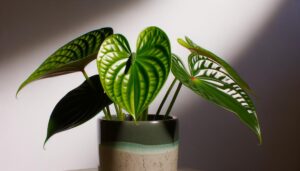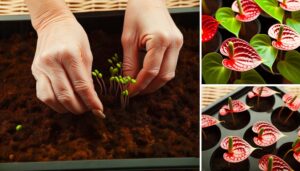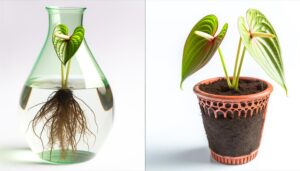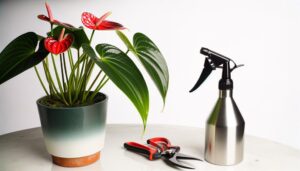The Best Soil Mix for King Anthurium – A How-To Guide
For King Anthurium, create a well-draining soil mix that retains moisture and nutrients. Combine sphagnum peat moss, orchid bark, and perlite in equal parts for ideal aeration and drainage.
Guarantee the mix's pH stays between 5.5 and 6.5 to support nutrient uptake. Use organic components like pine bark and coconut coir, and inorganic elements such as pumice and horticultural charcoal to enhance the soil structure.
Select a pot with ample drainage holes and space for root growth. Maintaining these soil conditions will keep your plant thriving.
To master the complete process, you could explore further.
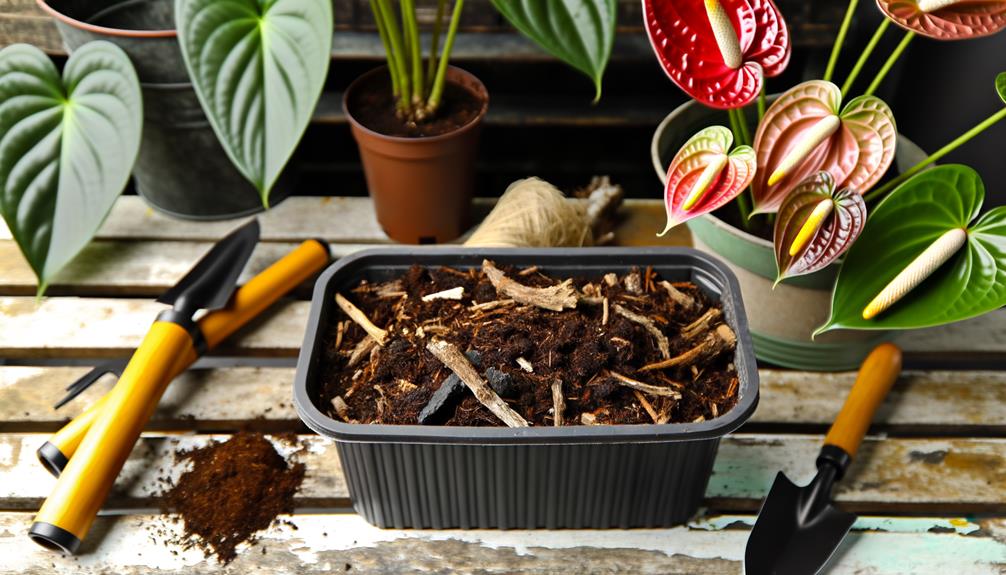
Key Takeaways
- Use a soil mix with peat moss, orchid bark, and perlite for optimal drainage, aeration, and moisture retention.
- Ensure the soil pH is slightly acidic to neutral, ideally between 5.5 and 6.5.
- Incorporate organic matter like coconut coir and sphagnum peat moss for nutrients and moisture.
- Add inorganic materials like perlite, pumice, and horticultural charcoal to enhance drainage and aeration.
- Select a pot with ample drainage holes and ensure it is slightly larger than the root ball.
Understanding King Anthurium Needs
Understanding King Anthurium needs begins with recognizing its preference for well-draining soil that retains moisture without becoming waterlogged. You need to ensure that the soil mix promotes aeration to support the plant's roots.
King Anthurium thrives in a slightly acidic to neutral pH range, ideally between 5.5 and 6.5. Organic matter, such as peat moss or coco coir, can help maintain the necessary moisture levels while providing nutrients.
It's essential to avoid compacted soils, as they can lead to root rot by trapping excess water. Incorporating perlite or orchid bark into the mix improves drainage and prevents water accumulation.
Key Soil Characteristics
You must guarantee your soil mix provides excellent drainage and aeration to prevent root rot and support healthy growth.
Include a nutrient-rich composition to supply essential minerals and keep the pH level balanced between 5.5 and 6.5 to optimize nutrient uptake.
Paying attention to these key soil characteristics will promote a thriving King Anthurium.
Drainage and Aeration Importance
For King Anthurium, maintaining proper drainage and aeration in the soil mix is crucial to prevent root rot and support healthy growth. You need a well-draining soil to prevent water buildup and ensure oxygen reaches the roots.
Incorporate materials that enhance both drainage and aeration:
- Perlite: Improves drainage and keeps the soil structure light.
- Pine Bark: Facilitates aeration and provides organic matter, aiding roots in breathing.
- Charcoal: Soaks up excess moisture and deters fungal growth.
- Sphagnum Moss: Holds onto moisture while still enabling airflow.
These components establish an optimal environment for the roots, balancing moisture retention with ample aeration. By using the correct mix, you'll promote strong root systems and overall plant health.
Avoid dense, heavy soils that can suffocate roots and result in weakened vitality.
Nutrient-Rich Composition
In addition to securing proper drainage and aeration, the soil mix for King Anthurium must be nutrient-rich to support strong growth and vibrant foliage. You'll want to incorporate organic and inorganic materials that provide essential nutrients such as nitrogen, phosphorus, and potassium.
| Component | Benefit |
|---|---|
| Coco Coir | Retains moisture, aeration |
| Perlite | Improves drainage |
| Compost | Nutrient supply |
Coco coir offers excellent moisture retention and aeration. Perlite enhances drainage, preventing root rot. Compost introduces crucial nutrients, promoting healthy plant development. This balanced composition ensures that your King Anthurium receives a steady supply of necessary nutrients while maintaining an optimal growing environment. Be diligent in mixing these elements thoroughly for the best results.
Ph Level Balance
Ensuring the soil's pH level is crucial for the best health and growth of King Anthurium, as it directly affects nutrient availability and absorption. Aim for a slightly acidic pH range of 5.5 to 6.5. This specific range helps the plant access essential nutrients like nitrogen, phosphorus, and potassium, and prevents toxic buildup of certain minerals.
Regularly test your soil's pH using a reliable pH meter or test kit. If adjustments are needed, consider these options:
- Use sulfur to lower pH levels.
- Add lime to raise pH levels.
- Incorporate organic matter, like peat moss, for gradual pH balance.
- Avoid over-fertilizing, which can disrupt pH levels.
Adhering to these guidelines will promote best growth for your King Anthurium.
Choosing Organic Components
Selecting natural components for your King Anthurium's soil mix involves considering materials that promote aeration, drainage, and nutrient retention. Choose high-quality sphagnum peat moss for its excellent moisture retention and slightly acidic pH, ideal for anthuriums.
Incorporate pine bark or orchid bark to enhance drainage and aeration, preventing root rot. Coconut coir is another great option, retaining moisture without compacting, and is more sustainable than peat moss.
Use compost sparingly to provide a balanced nutrient profile, but make sure it's well-decomposed to avoid introducing pathogens. Finally, add perlite or coarse sand for additional drainage while maintaining a light, airy structure.
Adding Inorganic Elements
To further enhance your King Anthurium's soil mix, integrating inorganic elements like perlite, pumice, or horticultural charcoal boosts drainage and prevents compaction, promoting ideal root health. These components create air pockets, enhancing aeration and reducing the risk of root rot.
Here's why you should consider each:
- Perlite: Lightweight and enhances soil structure.
- Pumice: Adds porosity and retains some moisture.
- Horticultural Charcoal: Absorbs impurities and prevents soil sourness.
- Expanded Clay Pellets: Excellent for root aeration and stability.
Incorporating these elements ensures a well-draining, airy substrate, essential for your King Anthurium's best growth. Mix them with your chosen organic components to create a balanced, supportive environment for your plant's root system.
Balancing Ph Levels
Maintaining the proper pH level in your King Anthurium's soil mix is crucial for optimal nutrient absorption and overall plant well-being. It's advisable to target a pH range of 5.5 to 6.5, which leans slightly towards acidity. Utilize a pH meter or test kit to routinely monitor the soil's pH levels.
If the pH is too elevated, you can reduce it by incorporating sulfur or natural materials such as pine needles. Conversely, if the pH is too low, introduce lime to raise it. Regularly assess the pH post watering and fertilization, as these actions may impact it.
Ensuring Proper Drainage
While balancing pH levels is important for nutrient absorption, ensuring proper drainage in your King Anthurium's soil mix is equally essential to prevent root rot and promote healthy growth.
You'll need to incorporate materials that enhance aeration and allow excess water to escape efficiently. Use a combination of coarse and fine particles to create a balanced structure.
Key components to include are:
- Perlite: Lightweight volcanic glass that improves aeration.
- Bark chips: Organic material that promotes drainage while maintaining moisture.
- Coarse sand: Enhances soil texture and prevents compaction.
- Charcoal: Helps absorb impurities and keeps the soil fresh.
Nutrient-Rich Additives
Incorporating nutrient-rich additives like worm castings and organic compost into your King Anthurium's soil mix will ensure the plant receives necessary minerals and beneficial microbes for optimal growth. Worm castings provide nitrogen, phosphorus, and potassium, essential for strong foliage and root development. Organic compost, on the other hand, enriches the soil with humus, enhancing moisture retention and soil structure.
Here's a quick reference table of nutrient-rich additives and their benefits:
| Additive | Benefits |
|---|---|
| Worm Castings | Nitrogen, phosphorus, potassium |
| Organic Compost | Humus, moisture retention, soil structure |
| Bone Meal | Phosphorus, calcium |
| Fish Emulsion | Nitrogen, trace minerals |
Consistently using these additives will keep your King Anthurium flourishing with lush, vibrant growth.
Mixing the Soil
To create the perfect soil mix for your King Anthurium, start by combining equal parts of peat moss, orchid bark, and perlite for best aeration and drainage. Confirm each component is thoroughly mixed to achieve a homogenous blend. This combination provides:
- Optimal aeration: Orchid bark and perlite prevent soil compaction.
- Adequate drainage: Perlite aids in reducing excess moisture.
- Moisture retention: Peat moss holds sufficient water for the roots.
- Nutrient availability: Each element contributes essential nutrients.
Once mixed, inspect the soil for even distribution of components. Adjust ratios if needed to match your specific environmental conditions.
This tailored mix guarantees your King Anthurium thrives, promoting healthy root growth and lush foliage. Avoid over-mixing to prevent breaking down the texture of the potting ingredients.
Potting Your King Anthurium
When potting your King Anthurium, select a pot that provides enough space for root growth and has ample drainage holes.
Guarantee proper drainage by adding a layer of coarse material, like gravel, at the bottom.
Regularly check root health, trimming any damaged roots and confirming they're not waterlogged.
Choosing the Right Pot
Selecting the right pot for your King Anthurium is crucial, as it directly impacts root health and overall plant growth. When choosing a pot, prioritize the following features:
- Material: Opt for clay or terracotta pots, as they allow better air circulation.
- Size: Guarantee the pot is slightly larger than the root ball to accommodate growth without causing waterlogging.
- Shape: A deeper pot can support robust root systems, promoting stability and nutrient uptake.
- Weight: Heavier pots provide stability, especially for larger plants.
Your King Anthurium will thrive in a pot that meets these criteria, ensuring that roots have ample space and airflow. By selecting the right pot, you set the foundation for a healthy, vibrant plant.
Proper Drainage Essentials
Promoting proper drainage is vital for potting your King Anthurium to prevent root rot and promote healthy growth. Begin by selecting a pot with sufficient drainage holes. These openings allow excess water to escape, preventing waterlogged soil.
Next, add a layer of coarse materials like gravel or broken terracotta at the bottom of the pot. This layer improves drainage and prevents soil from clogging the holes.
Use a well-aerated soil mix containing perlite, pine bark, and peat moss. This mix ensures water drains effectively while retaining the necessary moisture.
Regularly check the drainage by watering the plant and observing how quickly the excess water drains. Proper drainage is essential for maintaining the ideal moisture balance in your King Anthurium's soil.
Root Health Tips
Maintaining peak root health for your King Anthurium involves regularly inspecting the roots for signs of disease and ensuring they've ample space to grow. When repotting, gently remove the plant from its current container and examine the roots. Look for any mushy, discolored, or foul-smelling roots, and trim them with sterilized scissors. Use a fresh, well-draining soil mix to prevent waterlogging and root rot.
Consider the following tips for ideal root health:
- Use pots with drainage holes to avoid water accumulation.
- Repot annually to provide fresh nutrients and more space.
- Avoid overwatering by allowing the top inch of soil to dry out between waterings.
- Maintain humidity levels around 60-80% to mimic natural conditions.
Ongoing Soil Maintenance
Regularly monitor the soil's moisture levels to maintain the King Anthurium's health and thriving. Use a moisture meter to verify the soil stays evenly moist but not waterlogged.
Avoid overwatering by letting the top inch of soil dry out before watering again. Incorporate a well-draining mix with components like orchid bark, perlite, and peat moss to enhance aeration and prevent root rot.
Periodically check for compacted soil, which can hinder root growth; gently loosen it if necessary. Fertilize monthly with a balanced, water-soluble fertilizer during the growing season.
Additionally, repot your King Anthurium every 1-2 years to refresh the soil and support continued growth. Regular maintenance guarantees your plant remains healthy and vigorous.
Conclusion
You've crafted the perfect soil mix for your King Anthurium, much like an alchemist creating gold. By comprehending its needs and balancing organic and inorganic components, you've set the stage for a thriving plant.
Remember to monitor pH levels and add nutrient-rich additives regularly. Your meticulousness will guarantee that your King Anthurium reigns supreme in your garden.
Keep up the maintenance, and you'll be rewarded with a majestic, flourishing companion. Happy gardening!

